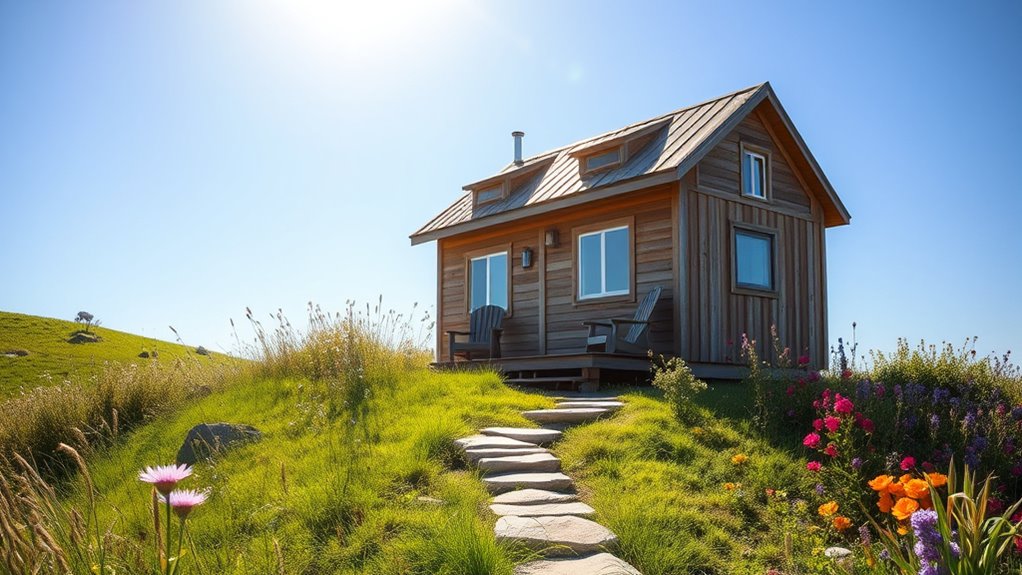Living in a tiny house teaches you to prioritize what truly matters by embracing minimalism and optimizing space. You’ll learn to use multi-purpose furniture, go vertical with storage, and create a layout that feels open and functional. Downsizing helps reduce clutter, stress, and unnecessary expenses, giving you more freedom and clarity. If you keep exploring, you’ll discover how these lessons can help you live with intention and contentment.
Key Takeaways
- Downsizing encourages intentional living, focusing on meaningful experiences rather than material possessions.
- Efficient use of space through multi-purpose furniture and vertical storage maximizes small homes.
- Simplifying living environments reduces stress and enhances mental clarity.
- Embracing minimalism promotes environmental sustainability and financial freedom.
- Small homes foster stronger connections and a more mindful, purpose-driven lifestyle.

Downsizing to a tiny house can be a rewarding experience, but it also requires a thoughtful approach. When you decide to embrace a smaller living space, you quickly realize that space optimization becomes your best friend. Every square inch counts, so you learn to prioritize what truly matters and find clever ways to make your limited area feel open and functional. Instead of cluttering your space with unnecessary items, you focus on creating a minimalist lifestyle—keeping only things that serve a purpose or bring you joy. This shift isn’t just about reducing possessions; it’s about changing your mindset to value quality over quantity and simplicity over excess.
As you start this journey, you discover that careful planning is essential. You’ll need to assess how you use your space daily and identify areas where you can maximize efficiency. Multi-purpose furniture becomes a game-changer—think fold-away beds, extendable tables, and storage ottomans. Vertical space also becomes valuable; shelving units and hanging organizers help you keep essentials within reach without sacrificing floor space. The key is to design a layout that promotes flow and ease of movement, making your tiny house feel larger than it actually is.
Adopting a minimalist lifestyle encourages you to rethink your relationship with possessions. It’s not just about decluttering; it’s about intentional living. You learn to ask yourself questions like, “Do I really need this?” or “Will this item add value to my life?” The process often feels liberating, as you shed unnecessary belongings and focus on the essentials. This mental shift helps you resist temptation and avoid accumulating clutter again, keeping your tiny house a calm, organized sanctuary.
You also find that downsizing isn’t just about the physical space—it’s about your daily routines and how you prioritize your time. With less space and fewer possessions, you tend to spend less time cleaning and maintaining, freeing you up for activities and relationships that truly matter. You become more mindful of your consumption habits, choosing quality over quantity and investing in durable, versatile items. This not only simplifies your life but also reduces your environmental footprint.
Ultimately, the lessons from downsizing to a tiny house teach you that less can be more. By focusing on space optimization and embracing a minimalist lifestyle, you create a home that’s efficient, peaceful, and tailored to your needs. It’s about living intentionally, making the most of what you have, and discovering that a big life doesn’t require a big house. Instead, it’s about the quality of your experiences and the freedom you gain from simplifying your surroundings.
Frequently Asked Questions
How Do Tiny House Owners Handle Storage Challenges?
You handle storage challenges by getting creative with your space. You maximize vertical space with tall shelves and wall-mounted storage, making every inch count. Multi-functional furniture, like beds with drawers or fold-away tables, helps you conserve space. You also declutter regularly, keeping only essentials. These strategies ensure you make the most of limited space while keeping your tiny home organized and functional.
What Are the Legal Regulations for Tiny Houses?
You need to understand zoning laws and building codes because they determine where and how you can place a tiny house. Regulations vary by location, so check local ordinances for restrictions on size, foundation type, and utility hookups. Some areas require permits or special approvals, while others are more flexible. Always research your area’s rules to avoid legal issues and guarantee your tiny house complies with all requirements.
How Do Tiny Houses Impact Mental Health and Well-Being?
Imagine downsizing to a tiny house and gaining mental clarity by decluttering your space. This reduction in clutter can boost emotional resilience, helping you feel more in control and less overwhelmed. Tiny houses often foster mindfulness and simplicity, which positively impacts mental health. You might find yourself sleeping better and feeling more energized, as the streamlined environment minimizes stress and promotes overall well-being.
What Are the Initial Costs Versus Long-Term Savings?
When considering initial costs versus long-term savings, you’ll find that upfront expenses are often higher due to land, permits, and construction. However, the financial benefits become clear over time, with lower utility bills, maintenance costs, and property taxes. You might face investment trade offs initially, but in the long run, downsizing can save you money, boost financial stability, and provide more freedom to focus on what truly matters.
How Do Tiny House Residents Host Guests Comfortably?
Ever wondered how tiny house residents host guests comfortably? You can optimize space by choosing multi-purpose furniture, like fold-out beds and extendable tables. Use clever storage solutions to keep the area clutter-free. Planning guest hosting as an event rather than a stay helps maximize comfort and space. With thoughtful space optimization, you make your tiny home welcoming, proving that great hospitality isn’t about size but smart design and attitude.
Conclusion
As you embrace the tiny house lifestyle, remember that less truly is more. Simplify your space, savor every second, and discover the joy of genuine freedom. Let minimalism motivate your mindset, and create a cozy, clutter-free haven that highlights happiness over possessions. By downsizing your dwelling, you access a world of wonder, wellness, and wisdom—where less baggage means more balance. So, step lightly, live fully, and let your small space spark a big, beautiful life.








